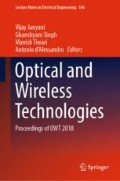Abstract
Channel coding for 5G New Radio is confronting everyday with novel challenges as to uphold and encourage various emerging use cases and new applications. State-of-the-art channel codes for existing mobile generations are already having questionable performance for many 5G applications. Polar code is prominent advancement in the channel coding area of this decade. The unprecedented performance of polar codes compelled 3GPP to adopt them for 5G eMBB control channels and over the physical broadcast channel. The 5G-URLLC scenario has strict requirement on the ultrahigh reliability and ultralow latency. Also, NR-URLLC scenario has analogous data rate necessity as that of the control channels. The low decoding complexity and latency with high reliability certainly makes polar code a strong contender in this race. This paper focuses on channel coding schemes particularly for NR-URLLC use case and evaluating the performance of polar codes for this scenario. Polar and LDPC code are compared on the basis of various parameters desired for URLLC scenario.
Access this chapter
Tax calculation will be finalised at checkout
Purchases are for personal use only
References
IMT Vision (2015) Framework and overall objectives of the future development of IMT for 2020 and beyond. Recomm ITU-R, M.2083, Sept 2015
Shafi M, Molisch AF, Smith PJ (2017) 5G: a tutorial overview of standards, trials, challenges, deployment and practice. IEEE J Sel Areas in Commun 99, Apr 2017
Sybis M, Wesolowski K, Jayasinghe K (2016) Channel coding for ultra-reliable low latency communication in 5G Systems. IEEE Veh Technol Conf, Sept 2016
Arıkan (2009) Channel polarization: a method for constructing capacity achieving codes for symmetric binary-input memoryless channels. IEEE Trans Inf Theory 55(7):3051–3073, July 2009
Ji H, Park S (2017) Introduction to ultra reliable and low latency communications in 5G. ArXiv: 1704.05565v1, Apr 2017
GPP TS 38.913 (2016) Study on scenarios and requirements for next generation access technologies, Mar 2016
R1-1611692 Channel coding schemes for URLLC scenario, Huawei, HiSilicon
Sharma A, Salim M (2017) Polar code: the channel code contender for 5G scenarios. IEEE Comptelix Conf, July 2017
Ercan F, Condo C, Hashemi SA (2017) On error-correction performance and implementation of polar code list decoders for 5G. ArXiv: 1708.04706v2, Oct 2017
R1-1610059 Evaluation of LDPC codes for eMBB, NTT DOCOMO, RAN1 #86bis, Lisbon, Portugal
R1-164040 (2016) On latency and complexity, Huawei, HiSilicon, May 2016
Tal I, Vardy A (2015) List decoding of polar codes. IEEE Trans Inf Theory 61(5):2213–2226, Mar 2015
R1-1706965 (2017) Polar coding design, Huawei, HiSilicon, June 2017
Huawei achieves 27Gbps 5G speeds with Polar Code. Retrieved 10 Oct 2016
R1-1609073 (2016) Discussion on latency of channel codes for NR, Samsung, Oct 2016
Author information
Authors and Affiliations
Corresponding author
Editor information
Editors and Affiliations
Rights and permissions
Copyright information
© 2020 Springer Nature Singapore Pte Ltd.
About this paper
Cite this paper
Sharma, A., Salim, M. (2020). Performance Evaluation of Polar Code for Ultrareliable Low Latency Applications of 5G New Radio. In: Janyani, V., Singh, G., Tiwari, M., d’Alessandro, A. (eds) Optical and Wireless Technologies . Lecture Notes in Electrical Engineering, vol 546. Springer, Singapore. https://doi.org/10.1007/978-981-13-6159-3_28
Download citation
DOI: https://doi.org/10.1007/978-981-13-6159-3_28
Published:
Publisher Name: Springer, Singapore
Print ISBN: 978-981-13-6158-6
Online ISBN: 978-981-13-6159-3
eBook Packages: EngineeringEngineering (R0)

